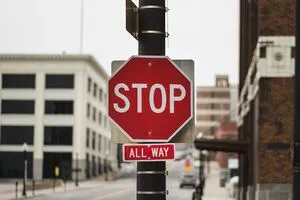In this article, we will help you understand what 4 way stop rules are and how having knowledge of the rules of 4 way stop can help you prevent an accident. Know the right of way at four way stops. Learn the four way stop rule and make sure you know who has priority. Don’t get into an accident – stay safe on the roads! If you have been in an accident due to someone’s negligence in following 4 way stop rule, consult our experienced car accident lawyers to win the compensation you deserve.
What is a Four-Way Stop?
A Four-way stop is a road intersection used for controlled traffic movement to ensure smooth traffic flow and avoid any accidents caused by motor vehicles. As a rule, the vehicles approaching a 4-way stop must come to a complete stop upon reaching the four-way stop to observe and apply the four-way stop rule before proceeding further. The 4-way stop rule dictates the right of way at the four-way stop. Usually, the vehicle arriving at the intersection first is given the right of way to move forward first as well. However, the four-way stop intersection does not provide absolute road safety, and the drivers must be aware of their surroundings before proceeding at the four-way stop.
Who has the right of way at a four way stop in case more than two vehicles reach the four-way stop?
In such a case, the vehicle on the right is given the right of way. A four-way stop is typically used in residential areas, parking lots, or other low-speed areas to encourage drivers to slow down. A four-way stop is easily recognized by the stop signs or flashing red lights to highlight the intersection.
The drivers must familiarise themselves with the 4-way stop rule in order to easily navigate the 4-way stop and avoid road-related accidents.
The Four Rules
Drivers must observe and follow the four basic rules of four way stop for effective navigation and smooth traffic flow, reducing the chances of accidents and traffic blockage by providing the drivers with equal opportunity to move through the four-way intersection.
What are the rules for a 4 way stop?
The first rule dictates observing a complete stop after arriving at the 4-way stop even if there are no other vehicles present at the four-way stop.
The second rule is to allow the right of way to the vehicle on the right in case of two or more vehicles arrive at the four-way stop to ensure that all drivers have equal opportunity to proceed through the intersection.
The third rule is to stop and give way to pedestrians and bicyclists.
The fourth rule is to indicate the turns you intend to make to your fellow drivers before proceeding. Any unindicated turn may cause an accident and damage to the vehicles and persons.
The rules for 4 way stop assist in what must you do at a four way stop sign and how does a four way stop work. By observing and following the rules of a four way stop, we can significantly reduce and control accidents and traffic congestion.
Four Tips for Four-Way Stops
A few tips may optimize the safe navigation of a 4-ways top i.e.
- Stop: Upon arriving at the four-way stop come to a complete stop to observe the rules of 4-way stop and asses the traffic at 4-way stop.
- Attention to surroundings: Look around before moving forward after reaching a four-way stop. Observe the vehicles at the 4-way stop to asses who has right of way at the four-way stop.
- Communication is the key: Effective communication is the key to smooth traffic flow and minimizing the risk of accidents. Use hand signals, turn signals, verbal communication & maintain eye contact with other drivers for effective communication.
- Patience: The 4-way stop rules encourage the drivers to be patient and cooperate with the other drivers upon arriving at the four way stops. The four-way stop sign signifies that the drivers must stop at the intersection to observe the rules of 4-way stop and analyze who has right of way at 4 way stop before proceeding.
The four way stop rules must be observed by all drivers in order to ensure and maximize road safety for everyone. The drivers must be patient and effectively communicate with each other to decide who goes first at a four way stop.
Four-Way Stop Accidents
Failure to observe and follow the rules of the four-way stop may cause accidents to the drivers and the people in the surroundings of the four-way stop. A few examples of accidents occurring at the 4-way stop are as follows:
- The driver failed to give right of way at a four-way stop causing a collision with the vehicle. The four way stop sign rules are a safe system for smooth traffic flow.
- Often vehicles at the back collide with the vehicle in front due to the driver’s negligence or distracted behavior.
- The rules of 4-way stop allow pedestrians and bicyclists a right of way. The drivers must observe the four way stop sign rule in this regard to avoid any unforeseen accidents to pedestrians and bicyclists.
- Ineffective communication may cause accidents at the four-way stop. The drivers may get confused regarding the right of way and misunderstand the rules of 4-way stop. It may also happen if the drivers are unaware of the 4-way stop rules as well.
Conclusion
To summarize, adhering to the regulations of a 4-way stop can substantially enhance driving assurance and avoid mishaps. It is imperative to stop entirely, grant the right of way to the car on the right, give priority to pedestrians and cyclists, and use effective communication before proceeding. Additionally, being patient and cooperative with other drivers is crucial for secure maneuvering. Neglecting these guidelines may result in crashes and harm. By complying with the principles of a 4-way stop, drivers can facilitate smooth traffic, decrease accident hazards, and ensure the safety of all road users.
- Key Facts About Missouri’s No Pay No Play Law - 28th May 2025
- Understanding Taxes on Personal Injury Settlements - 23rd May 2025
- Navigating Your Rights After a Car Crash While Pregnant - 21st May 2025


